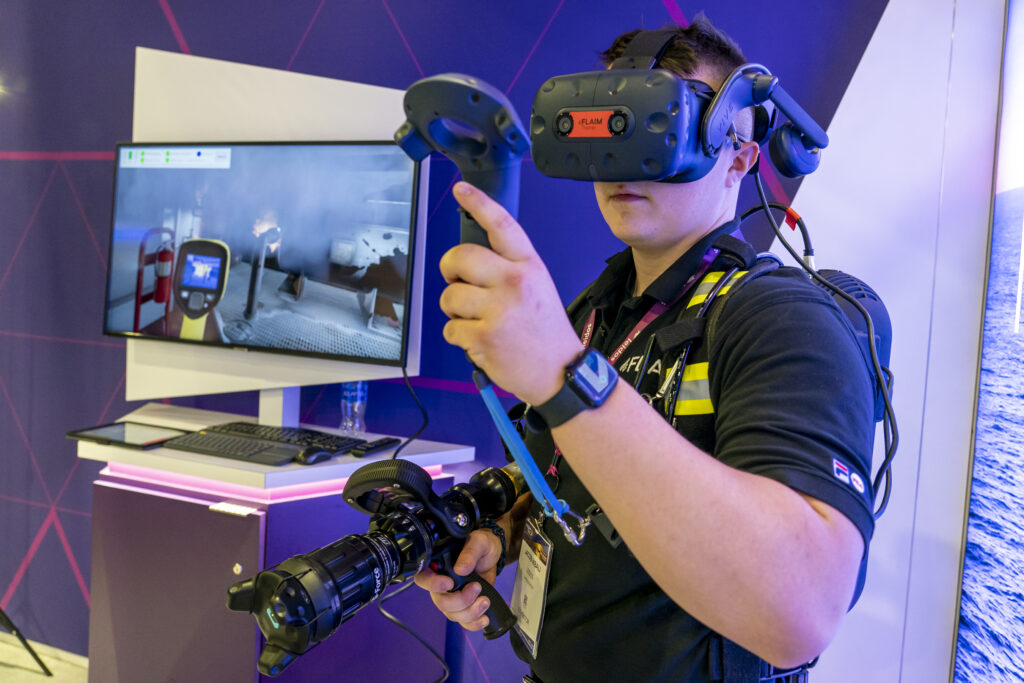
NATIONAL HARBOR, Md. — From hands-on demos to stadium-quality video screens, more than 300 exhibitors are presenting the latest defense technology to Sea-Air-Space attendees. Here are some of the highlights from the Prince George’s Exhibit Hall, which will be open today from 9 a.m. to 3:30 p.m.
General Dynamics (Booth 1023) is showcasing its Columbia-class nuclear submarine. This replacement for the aging Ohio class of ballistic submarines is scheduled to be delivered to the U.S. Navy in 2027, said Greg Rose, General Dynamic’s chief of public affairs.
The Columbia class, which will be built into the 2040s, is similar in design to the Ohio class, but with some significant changes, Rose said. At 560 feet long with a displacement of nearly 21,000 tons, the Columbia-class fleet will be the largest submarines ever built in the U.S. They also will have a fuel core that lasts the life of the ship, eliminating the need for a mid-service refueling.
At Booth 737, Leidos has a replica of Sea Hunter, which along with Sea Hawk, are the first autonomous unmanned surface vessels used by the U.S. Navy.
The carbon-fiber craft have software that allows them to navigate the “rules of the road on the sea,” said Leidos representative Matthew Garner. Sea Hunter recently completed a trip from San Diego to Pearl Harbor in Hawaii, completely unmanned. Together, Sea Hunter and Sea Hawk have logged more than 40,000 autonomous miles, Halley said.
There will likely be future iterations of Sea Hunter, Garner said, noting the U.S. Navy is calling for 150 ships in its 500-ship fleet to eventually be unmanned.
SAIC (Booth 803) conducted a demonstration of its virtual mission center Tuesday afternoon, communicating entirely virtually with a mission center in Aurora, Colorado.
“Traditional operations centers need people to perform the functions, but our mission center allows networking in a virtual environment across the entire planet,” said Gardner Congdon, SAIC’s director of extended realities domain.
SAIC uses virtual reality and tactical software for its virtual mission center, which is currently a use case for the Space Force, Congdon said.
L3Harris Technologies (Booth 1037) is giving demonstrations of its new BNVD Fused Binocular Night Vision Goggle. The goggles fuse image-intensified tubes with a thermal camera to help detect heat and overlay. This is particularly useful for identifying hidden targets like someone in camouflage in the woods, said Leith Ames with L3Harris.
Visitors to the booth can see the goggles in action, with both visual and thermal images captured on a screen in real time.
HII (Booth 1322) is using its booth to showcase its rebranding from Huntington Ingalls Industries to HII. Along with models devoted to the company’s traditional background in shipbuilding, there are also exhibits of autonomous vehicles and other technologies.
Director of Communications Greg McCarthy pointed out displays of Odyssey, HII’s new suite of advanced autonomy solutions that can turn any ship or vehicle in any domain into an intelligent, robotic platform.
HII is also debuting integrated digital shipbuilding. USS Enterprise CVN-80 is the company’s first digitally designed aircraft carrier. Enterprise is currently in the keel-laying phase of construction, McCarthy said.
- Combatting Climate Change - April 5, 2023
- CMS Panelists Envision Future American Sea Power - April 5, 2023
- U.S. Navy Embraces Diversity Initiatives - April 5, 2023




